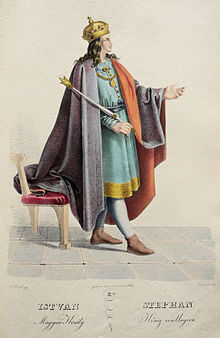Stephan IV (Hungary)
Stephan IV. ( Hungarian IV. István , Croatian Stjepan IV. (Kralj Hrvatske i Ugarske) ; * around 1133; † April 11, 1165 ) was the Hungarian antagonist to Stephan III. He ruled from January 27, 1163 until 1165. His father was called Béla II , his mother was called Ilona and was the daughter of the Serbian ruler Uros I. He was the third son of Béla, and the struggles for power filled his whole Life out.
Struggle for power under Géza II.
Stephen IV was mentioned for the first time in 1152. At that time the two nephews of Géza II. , D. H. Ladislaus and Stephan (IV.) Appointed Hungarian princes. Under the government of Géza the royal power was still stable, but slowly a new social class arose, which claimed the title of king and were dissatisfied with the government of Géza II.
So after a quarter of a century the struggles for the throne in monarchical Hungary flared up again. According to a Greek source, Stephan (IV.) Was very greedy for power. To support his claim to the throne, Stephan conspired with the Ban of southern Hungary, Belos. Their conspiracy against Géza II in the spring of 1157 failed and they had to flee. Stephan sought protection at the court of Friedrich Barbarossa . However, the emperor made a decision in favor of King Géza on January 13, 1158, at the same time he allowed Stephan to leave the court and flee to Constantinople .
Frederick I was busy with the Italian campaigns at the time, but the fact that Géza, after the Battle of Fischa in the summer of 1157, also played a major role in this decision, began with such a policy that greatly improved German-Hungarian contacts. He gave his daughter to the Czech heir to the throne, Friedrich Barbarossa's ally (the rest of whom was also called Friedrich). In addition, Géza offered armies at the disposal of Emperor Frederick to support the Italian campaigns.
Times of Byzantine interference
Stephan was received with joy in the Byzantine court. Manuel's niece, Maria became Stephan's wife. The imperial court could not yet deal with Stephen's plans, because Manuel I fought until 1161 to secure the eastward expansion.
Meanwhile in Hungary, Ladislaus also carried out a conspiracy, but it also failed. In 1160 the prince also had to flee to Constantinople. He was also offered a wife, but Ladislaus refused the offer.
After the death of Géza II, Manuel decided that he would make Hungary a Byzantine vassal. The Hungarian Kingdom had to endeavor to maintain its independence in the coming periods.
Persuasion, military action and corruption were all the means by which Manual sought to achieve his goal. After the fighting, the Hungarians made a compromise with Byzantium, according to which not Stephan (IV.), But Ladislaus became king. Stephan became a duke who had power over a third of the country. Stephan III. had to flee to Pozsony .
Ladislaus died on January 14, 1163, Stephan was now able to satisfy his lust for power and became King of Hungary. He was crowned by Miko, Archbishop of Kalocsa on January 27, 1163. Lukács, the Archbishop of Gran , did not recognize this decision. Stephan was very unpopular in Hungary anyway. When he realized that there was an uprising against him, he called Greek soldiers for his support.
But Friedrich Barbarossa did not like that, because he did not want Byzantium to gain too much influence on the south-eastern border region of the Holy Roman Empire . So the emperor supported Stephan III. in the fighting and after the Greek armies had left the country, the armies of Stephen III marched. going inland. On June 19, 1163, Stephan IV lost the battle near Székesfehérvár . In this battle Ban Belos also died and Stephan IV was captured, but Stephan III. allowed him to flee to Byzantium.
Three more times, until 1165, Manuel tried to force Hungary under his influence, without success. Even then, Stephan IV had no supporters in the country. In the closed peace Manuel recognized the sovereignty of Stephan III. on. Prince Béla, Stephen's brother also went to the Byzantine court.
Stephan IV was murdered by his followers in the Zimonyer (today in Serbia: Zemun ) castle. He was long accused of instability on the royal throne and people did not want to bury him for a long time.
Finally, Stephan IV was buried in Székesfehérvár.
About the heir to the throne see: Stephan III. or the list of rulers of Hungary
| predecessor | Office | successor |
|---|---|---|
| Stephan III. |
(Counter) King of Hungary 1163 |
Stephan III. |
literature
- Ferenc Makk: IV. István. In: Gyula Kristó, Ferenc Makk: Az Árpádok. Fejedelmek és királyok. Szukits Könyvkiadó, Budapest 2003, ISBN 963-9278-48-3 .
- Ferenc Makk: Magyarország a 12. században. Gondolat, Budapest 1986, ISBN 963-281-660-9 ( Magyar história ).
- Kristó Gyula : Háborúk és hadviselés az Árpádok korában. 2. kiad. Szukits Könyvkiadó, Budapest 2003, ISBN 963-9441-87-2 .
| personal data | |
|---|---|
| SURNAME | Stephan IV. |
| BRIEF DESCRIPTION | Hungarian counter-king Stephan IV (1163) |
| DATE OF BIRTH | around 1133 |
| DATE OF DEATH | April 11, 1165 |
